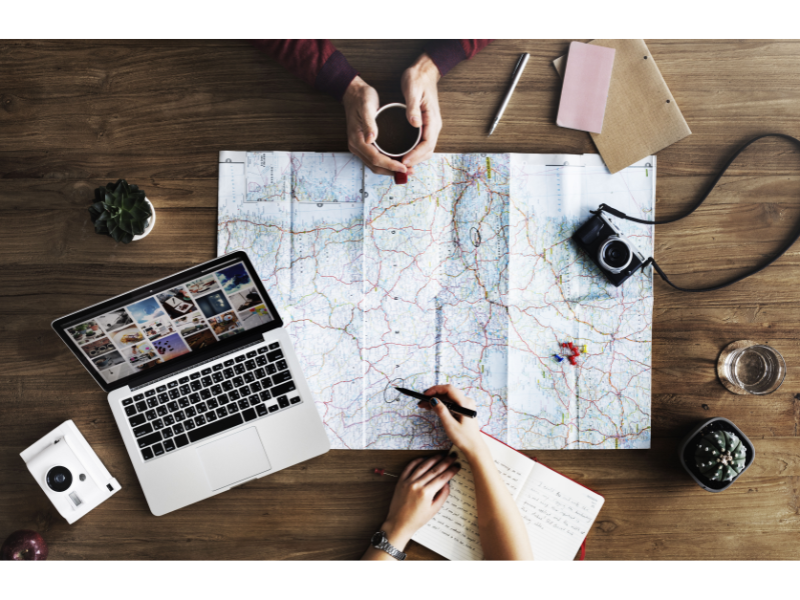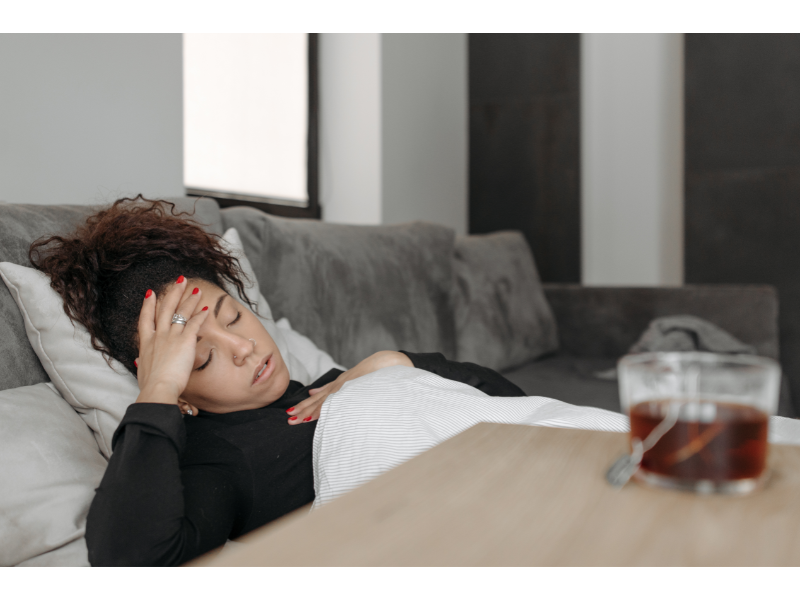Traveling with chronic migraines can feel like navigating a minefield. But fear not, fellow migraine warriors! This ultimate guide equips you with battle strategies to minimize those painful attacks and maximize your travel adventures.
How Travel Triggers Affect People with Migraines
This table summarizes a survey conducted by Condé Nast* on how travel affects people with migraines.
| Travel Factor | Percentage of Migraine Sufferers Affected |
|---|---|
| Triggers Migraines | 37% |
| Top Triggers | * Stress and Anxiety (65%)<br> * Dehydration (63%)<br> * Noisiness (62%) |
| Stress of Migraine Attacks | * Very Stressful (57%)<br> * Somewhat Stressful (37%) |
| Cancelled/Delayed Travel Plans | 89% |
Source: Nurtec
Know Your Enemy: Understanding Migraines
Migraines are far more than just headaches. These neurological beasts can unleash a barrage of symptoms, including throbbing pain, nausea, sensitivity to light and sound, and even aura (visual disturbances). Understanding your specific triggers is crucial for effective travel planning. The American Migraine Foundation (https://americanmigrainefoundation.org/) offers a wealth of resources to help you identify your triggers and create a personalized management plan.

Why Travel Triggers Migraines
Traveling is a joy, but for migraine sufferers, it can also be a minefield of potential triggers. Here’s why travel can be such a headache (literally!):
-
Disrupted Routine: Our bodies thrive on consistency. Travel disrupts your sleep schedule, meal times, and overall routine. These inconsistencies can throw your internal clock out of whack, triggering a migraine attack.
-
Stress and Anxiety: The excitement (and sometimes dread) of a new adventure, unfamiliar environments, potential delays, and the pressure to have a good time – all these factors can contribute to stress and anxiety, well-known migraine triggers.
-
Dehydration: Airplane cabins have a notoriously low humidity level, which can dehydrate you quickly. Dehydration is a major culprit for many migraines. Stock up on water and avoid sugary drinks that can worsen dehydration.
-
Changes in Pressure: The air pressure changes during airplane takeoff and landing can trigger migraines in some people. Similarly, fluctuations in barometric pressure due to weather changes can also be a factor.
-
Sensory Overload: Bright airport lights, loud announcements, crying babies on planes, unfamiliar smells in new places – a travel adventure can be a sensory assault for anyone. For people with migraines, this overload can be a trigger.
Beyond the Big Five: These are some additional factors to consider:
-
Dietary Changes: Eating unfamiliar foods or indulging in too much processed food while traveling can trigger migraines in some people. Stick to your usual diet as much as possible, or pack healthy snacks to avoid unhealthy temptations.
-
Lack of Sleep: Jet lag and disruptions to your sleep schedule can be a major trigger. Here are some tips in the next section to help you maintain a consistent sleep pattern while traveling.
-
Increased Alcohol or Caffeine Intake: Changes in your usual consumption patterns of alcohol or caffeine can trigger migraines. Be mindful of your intake while traveling.
Gallivanting Souls is reader-supported. When you buy through links on our site, we may earn an affiliate commission. As an Amazon Associate, I earn from qualifying purchases. Learn more.
Demystifying Travel Headaches: Causes, Treatments, and Prevention Tips
Traveling is exhilarating, but headaches can throw a wrench in your adventures. This guide equips you with the knowledge to combat these travel foes and keep your journeys blissful.
Understanding Travel Headaches
Headaches are a common travel companion, affecting many people during air, land, or water travel. These headaches can be broadly categorized into two types:
- Airplane Headaches: These are specific to air travel and cause intense, but temporary, pain at the front of the head, typically resolving within 30 minutes of landing.
- Motion Sickness Headaches: These occur due to motion sickness experienced during car travel, train rides, or sea voyages. They can trigger migraines in some individuals.
What Causes Them?
- Airplane Headaches: The culprit is likely pressure changes in the cabin during takeoff and landing. Theories suggest these changes might cause blood pressure fluctuations in the brain or minor tissue injury in the sinuses.
- Motion Sickness Headaches: This syndrome arises from conflicting sensory information. Your eyes perceive movement, while your inner ear might not register it as strongly. This confusion triggers a response in the brain similar to poisoning, leading to nausea and headaches as a warning sign.
Symptoms to Watch Out For:
- Airplane Headaches: Sharp, stabbing, or throbbing pain concentrated in the forehead. In rare cases, dizziness, pins-and-needles sensation in the face or hand, might occur.
- Motion Sickness Headaches: Primarily nausea, but can also include dizziness, sweating, fatigue, and a general feeling of unwellness.
Taming Travel Headaches: Treatments and Management
- General Treatments: Over-the-counter pain relievers like acetaminophen can offer relief.
- Motion Sickness Management: Strategies to reduce motion sickness include:
- Minimizing body movement.
- Focusing on a stable point like the horizon.
- Avoiding reading or looking at screens.
- Facing the direction of travel (on trains or ships).
- Controlled breathing exercises.
- Medications: Anti-nausea medications can be helpful, but consult your doctor about potential side effects. If you often get motion sickness Meclizine, available on Amazon may be helpful.
Preventing Travel Headaches: Be Prepared, Not Scared
The key to avoiding travel headaches lies in understanding your triggers. Here’s how to be proactive:
- Identify Your Triggers: Recognize what aspects of travel trigger your headaches (pressure changes, car fumes, etc.)
- Mental Preparation: Knowing your triggers allows you to mentally prepare and potentially increase your tolerance for them.
- Hydration is Key: Dehydration can worsen headaches. Drink plenty of water throughout your journey. Bring a travel water bottle like this one on Amazon and refill often.
- Dietary Choices: Consider avoiding heavy meals or foods that might trigger headaches for you.
- Medications: If you require medication, consult your doctor about taking it before travel to minimize headaches.
Frequently Asked Questions (FAQ):
- What is a travel headache called? Airplane headaches during air travel are a specific type. Motion sickness is the broader syndrome causing headaches during various forms of travel.
- Can air travel cause headaches? Yes, air pressure changes and dehydration during air travel can contribute to headaches.
- How to stop travel headaches? Medications, acupressure bands, and managing motion sickness can all help.
Remember: Travel headaches are common but manageable. By understanding the causes, implementing preventive measures, and having a treatment plan in place, you can minimize their impact and ensure a smooth, headache-free adventure!

Planning is Power: Pre-Trip Preparation
- De-Stress Your Itinerary: Anxiety is a major migraine trigger. Combat it with meticulous planning. Create detailed packing lists to avoid last-minute scrambling, and research your destination’s climate to anticipate potential triggers like extreme heat or barometric pressure changes.
- Medications Matter: Don’t let a medication mishap ruin your trip. Refill prescriptions well in advance and pack more than you anticipate needing. Always carry your medications in your carry-on luggage for easy access in case of checked baggage delays.
- Be International Med-Savvy: Traveling overseas requires extra planning. Obtain a doctor’s letter explaining your medications and their purpose. Keep medications in their original packaging for customs officials. Research import restrictions for your destination country to avoid problems at the border.
Routine is Your Ally: Sticking to the Familiar
- Sleep Soldiers: Fight jet lag with consistency! As much as possible, maintain your regular sleep schedule, even if it means adjusting gradually. Set reminders for medication and meals to keep your body’s internal clock on track.
- Pack for Comfort: Be your migraine’s worst nightmare by packing comfort essentials. Sunglasses shield your eyes from bright lights, a sleep mask ensures darkness during travel, and a scarf offers versatility – blocking light, covering your face from strong smells, or providing warmth. Consider including eye drops and earplugs for additional sensory relief.
- Bring more than enough medication just in case as well as a travel emergency kit.

Relaxation is Your Weapon: De-Stressing on the Go
- Screen-Free Sanctuary: Give your eyes and brain a break! Put away electronic devices and focus on relaxation techniques like deep breathing exercises, meditation, or progressive muscle relaxation. Consider downloading guided meditations or relaxation apps for easy access on the go.
- Noise-Canceling Nirvana: Invest in noise-canceling headphones to block out airplane noise, crying babies, or chatty seatmates. Keep music volume low to avoid further irritation. Consider headphones with ambient noise control features that allow you to hear important announcements while blocking out background noise.
- Temperature Tactics: Pack a reusable ice pack or a DIY heated sock filled with rice for targeted pain relief. Some people find relief from applying gentle pressure to their forehead or temples. Consider a travel-friendly head wrap or eye mask with built-in cooling or heating properties.
Hydration is Your Hero: Staying Water-Wise
- Bring Your Own Bottle: Dehydration is a common migraine trigger. Pack a reusable water bottle and refill it frequently throughout your day. Consider investing in a water bottle with motivational markings to help you stay on track.

Listen to Your Body: Be Your Own Best Advocate
- Flexibility is Key: Don’t be a slave to your itinerary. If you feel an attack coming on, prioritize rest and relaxation. Be prepared to adjust plans or activities to accommodate your needs. There’s always something to enjoy, even from a comfy hotel room.
- Communicate Openly: Let your travel companions know about your migraines and their potential impact on the trip. Their understanding and support can make a world of difference.
- Celebrate Small Victories: Even a migraine-free hour is a win! Savor the good moments, big and small. Focus on creating positive travel memories, not dwelling on potential attacks.

Migraine Bonus Tips:
- Travel Insurance: Consider travel insurance, especially if migraines frequently disrupt your plans.
- Explore Alternative Treatments: Research and discuss complementary therapies with your doctor, such as acupuncture or acupressure, which might offer additional relief during travel.
- Pack Healthy Snacks: Maintain your blood sugar levels with healthy, travel-friendly snacks like nuts, granola bars, or dried fruit.
- Research Accommodation: Look for hotels or accommodations with blackout curtains and amenities that promote relaxation, such as spas or in-room massage services.
- Be Kind to Yourself: Traveling with migraines requires extra patience and self-care. Don’t be afraid to ask for help from travel companions or service providers. Pack activities
Conclusion: Conquering Travel with Confidence
Traveling with headaches doesn’t have to be a daunting experience. By understanding your triggers, implementing preventative measures, and having a plan for managing them, you can transform travel headaches from a nuisance to a minor blip on your adventure radar. Embrace the knowledge you’ve gained, pack your essentials (medication, water bottle, etc.), and set off to explore the world with confidence! Remember, the most beautiful destinations are often worth a little preparation and proactive care. Happy travels!
Conquering Migraines and Conquering the World: Frequently Asked Questions
Traveling with migraines can feel like a gamble. This FAQ aims to equip you with the knowledge to make informed decisions and navigate your adventures with confidence.
Can I Still Travel With Migraines?
There’s no one-size-fits-all answer. The severity of your migraines, your triggers, and the nature of your trip all play a role. Here are some questions to guide your decision-making:
- Impact of Migraines: Would migraines significantly disrupt your enjoyment of the trip?
- Enjoyment During Attacks: Can you still find moments to appreciate your surroundings even with a migraine?
- Likelihood of Attacks: How likely are you to experience migraines during travel, considering stress levels and potential triggers?
- Timing Considerations: Is there a better time to schedule your trip to minimize potential triggers?
For instance, jet lag and disrupted sleep routines can worsen migraines. Consider destinations with minimal time zone changes if that’s a trigger for you. Similarly, stressful situations like language barriers can exacerbate migraines.
How Can I Minimize Migraines While Traveling?
While eliminating migraines entirely might not be possible, you can take steps to reduce their frequency and severity:
- Accommodation: Choose lodging in quieter areas with minimal light pollution if bright lights and noise are your triggers. Consider amenities like blackout curtains or in-room spa services that promote relaxation.
- Schedule Consistency: Maintain a consistent sleep schedule as much as possible, even with early mornings or late nights. Pack healthy snacks to avoid missing meals due to busy sightseeing. If exercise helps manage your migraines, look for accommodations with nearby fitness facilities.
- Monitor Your Health: If your migraines worsen significantly after traveling or you experience new symptoms, consult your doctor to rule out other potential causes.
What Should I Prepare Before My Trip?
- Adjust Sleep Schedule: Gradually shift your sleep schedule to match your destination’s time zone before departure. This helps minimize jet lag, a common migraine trigger.
- Trip Cancellation/Insurance: Consider trip cancellation insurance, especially if you have chronic migraines. Travel health insurance can also be valuable in case you need medical attention during your trip. Keep documentation like receipts or contracts handy in case of cancellation.
- Flexible Itinerary: Plan a loose itinerary that allows for rest days if needed. Explain your situation to travel companions so they understand and can be supportive. Pack activities you can enjoy from your hotel room in case of an attack.
What if I Get a Migraine at the Airport or on the Plane?
Airports and airplanes can be triggering environments due to noise and close quarters. Here are some tips:
- Contact the Airport: Inquire about quieter areas to wait for your flight. Some airports offer designated relaxation zones.
- Request Seating: Ask the airline about less crowded seating options on the plane.
- Be Prepared: Pack your medication, noise-canceling headphones, and a sleep mask to manage symptoms if a migraine strikes.
With careful planning and these tips in mind, you can minimize the impact of migraines and transform your trip into an unforgettable adventure.

